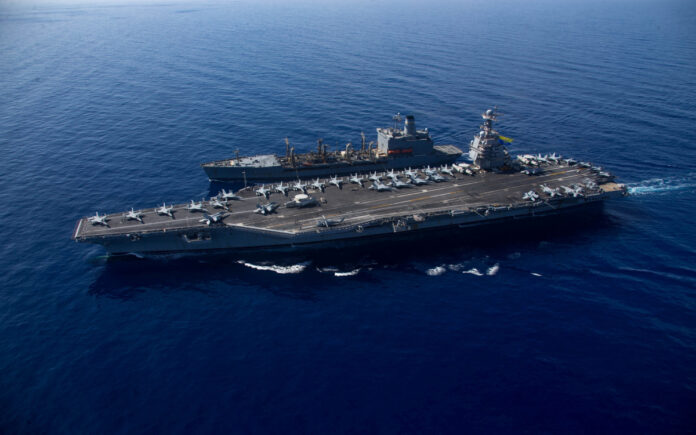Washington: The United States has maintained a heightened military presence in the Middle East for over a year, positioning approximately 40,000 troops, at least a dozen warships, and four Air Force fighter squadrons across the region. This force is intended to protect allies and deter potential attacks, several US officials confirmed. As clashes between Israel and Hezbollah intensified this week, concerns are mounting over the possibility of the conflict escalating into a full-scale war. Tel Aviv continues its nearly yearlong battle against Hamas militants in Gaza.
Hezbollah, backed by Iran, has declared that Israel crossed a “red line” with explosive strikes on its communication systems. The group vowed to sustain its missile attacks, which began following Hamas’s assault on Israel on October 7 last year, igniting the ongoing Gaza war.
Israeli Defense Minister Yoav Gallant, who has been in frequent contact with US Defense Secretary Lloyd Austin, announced the beginning of a “new phase” in the conflict, shifting focus toward confronting Hezbollah in northern Lebanon.
Despite the increased hostilities, the US has not signaled any troop reinforcement or adjustments in response to the latest attacks, relying on its already robust forces in the area.
“We’re confident in the capability of our current forces to protect our interests and assist in the defense of Israel if necessary,” Pentagon spokeswoman Sabrina Singh stated on Thursday.
A military official revealed that the additional resources have allowed the US to continue patrolling various conflict zones, including operations against the Islamic State in Iraq and Syria, defending Israel, and addressing threats from Iran-backed Houthi rebels in Yemen. These rebels have targeted commercial vessels in the Red Sea and launched ballistic missiles toward Israel.
The officials spoke anonymously to discuss the sensitive details of US military deployments.
U.S. Military Presence in the Middle East
Troops
The US typically has around 34,000 troops stationed under US Central Command, covering the Middle East. However, that number grew to approximately 40,000 at the onset of the Israel-Hamas war due to the deployment of additional ships and aircraft. In recent weeks, the total number briefly surged to nearly 50,000 when Austin ordered two aircraft carrier groups to the region amid escalating tensions between Israel and Lebanon. One carrier strike group has since relocated to the Asia-Pacific, reducing the number of carriers in the area.
The augmented force is aimed at defending Israel and ensuring the safety of US and allied personnel and assets.
Also Read | Taiwan Questions President of Pager Firm Linked to Hezbollah Explosions
Warships
The US is currently operating with one aircraft carrier in the region. Over the past year, Austin has extended the deployments of carriers on multiple occasions, leading to rare instances where two carriers were stationed in the area simultaneously.
Military officials have long asserted that the presence of an aircraft carrier—with its fighter jets, surveillance aircraft, and advanced missile systems—serves as a powerful deterrent to Iran.
Currently, the USS Abraham Lincoln, accompanied by three destroyers, is stationed in the Gulf of Oman, while two US Navy destroyers are patrolling the Red Sea. The USS Georgia, a guided-missile submarine sent to the region last month, remains within US Central Command, though its exact location remains undisclosed.
Additionally, six US warships are positioned in the eastern Mediterranean, including the USS Wasp amphibious assault ship, which is carrying the 26th Marine Expeditionary Unit. Three Navy destroyers are also patrolling the same waters. Some F/A-18 fighter jets from the USS Abraham Lincoln have been relocated to a land base, though officials have not revealed the specific location.
Also Read | Zelenskyy to Unveil ‘Victory Plan’ in US, Eyes Key Meetings with Biden and Trump
Aircraft
Last month, the Air Force deployed an additional squadron of F-22 fighter jets, bringing the total number of fighter squadrons in the Middle East to four. These squadrons include A-10 Thunderbolt II ground attack aircraft, F-15E Strike Eagles, and F-16 fighter jets. As with the warships, the Air Force has not disclosed the countries hosting the aircraft.
The deployment of F-22 fighter jets enhances US capabilities with their stealth and advanced sensors, allowing them to suppress enemy air defenses and coordinate operations with other warplanes.
The US has also demonstrated its ability to conduct long-range strikes from outside the Middle East. In February, two B-1 bombers flew a 30-hour roundtrip from Texas to strike 85 Islamic Revolutionary Guards Corps Quds Force targets in Iraq and Syria, following an attack by IRGC-backed militias that resulted in the deaths of three US service members.



